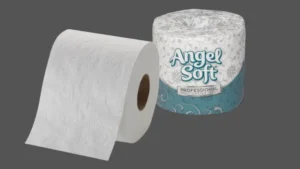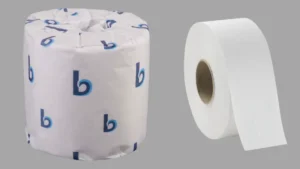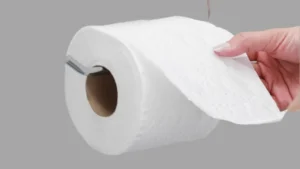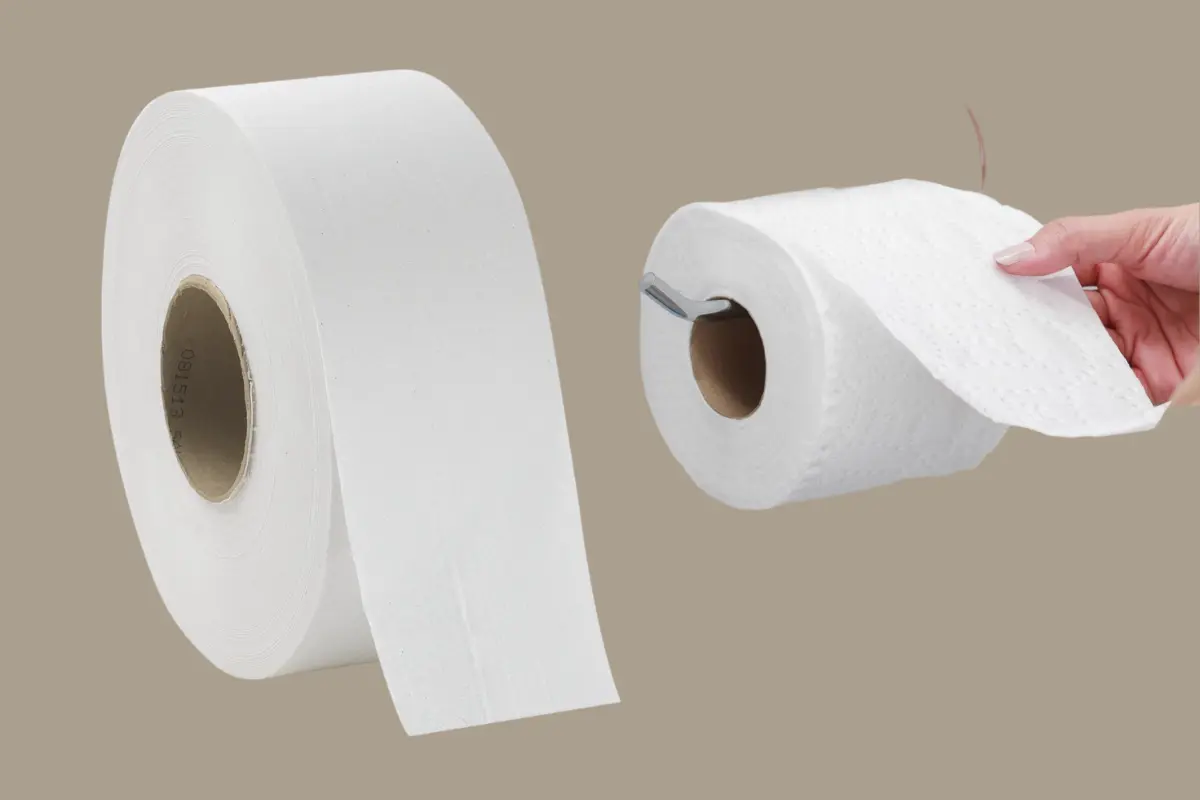Bath tissue vs toilet paper are the same product. Both terms refer to the paper used for personal hygiene after using the toilet.
Bath tissue or toilet paper is an essential household item. It is used for maintaining personal hygiene and cleanliness. Typically made from soft, absorbent paper, it ensures comfort and effectiveness. Available in various types, including single-ply and multi-ply, it caters to different preferences.
Some brands offer eco-friendly options made from recycled materials. This common household staple comes in rolls or sheets and is a crucial part of daily life. Its primary purpose is to clean and dry the skin, ensuring a hygienic experience. Understanding the different types and their benefits can help you make an informed choice for your household needs.
Bath Tissue Vs Toilet Paper
In the world of bathroom essentials, the terms “bath tissue” and “toilet paper” often cause confusion. Both serve the same basic function, but are there any differences? Understanding the nuances between bath tissue and toilet paper can help you make a better choice for your household needs.
Material Differences
When discussing the differences between bath tissue and toilet paper, the material composition is crucial. Both products are made from paper, but the type of paper and the processing method can vary significantly.
Bath tissue is typically made from virgin pulp, which means it uses new, unused fibers. This creates a softer and more luxurious feel. Toilet paper, on the other hand, can be made from recycled paper. This makes it more environmentally friendly but can sometimes result in a rougher texture.
Here is a comparison table for better understanding:
| Type | Material | Texture |
|---|---|---|
| Bath Tissue | Virgin Pulp | Softer |
| Toilet Paper | Recycled Paper | Rougher |
Bath tissue often undergoes additional processing steps, such as embossing and perforation, making it feel more premium. Toilet paper may not go through these extra steps, keeping costs lower and focusing on practicality.
Ply Count Variations
The term “ply” refers to the number of layers in the paper. The more plies, the thicker and more absorbent the tissue.
Bath tissue usually comes in 2-ply or 3-ply variations. This makes it softer and more durable. Toilet paper, however, is often available in 1-ply or 2-ply options.
Here is a breakdown of the ply differences:
- 1-ply: Single layer, thinner, less absorbent.
- 2-ply: Double layer, balanced thickness, better absorbency.
- 3-ply: Triple layer, thickest, most absorbent, and softest.
Consumers looking for a more luxurious experience often choose bath tissue with a higher ply count. Toilet paper with lower ply counts is more economical and serves the basic purpose effectively.
Bath Tissue Meaning
Bath tissue is a term often used to describe higher-quality toilet paper. It implies a product that is softer, more absorbent, and generally more pleasant to use.
The term “bath tissue” is favored by premium brands aiming to differentiate their products. These brands focus on comfort, luxury, and superior performance.
Bath tissue is often marketed with features such as:
- Extra softness for a more comfortable experience.
- Increased absorbency for better performance.
- Luxurious feel to enhance user satisfaction.
Understanding the meaning of bath tissue helps consumers make informed choices. It’s not just about function; it’s about the overall experience and quality.

What Is Bath Tissue Used For
Bath tissue and toilet paper are terms often used interchangeably. Yet, they serve specific purposes. Bath tissue is a type of toilet paper, but not all toilet paper qualifies as bath tissue. Understanding the distinctions between these two can help you choose the right product for your needs.
What Is Bath Tissue Used For?
Bath tissue primarily serves as a sanitary product for personal hygiene. It is designed to be soft, absorbent, and gentle on the skin. People use it daily in bathrooms for cleaning after using the toilet.
Personal Hygiene
Bath tissue provides a comfortable and effective way to clean after using the toilet. It is an essential item in every household. The soft material ensures that it does not irritate sensitive skin.
Facial Tissues
Some people use bath tissue as a substitute for facial tissues. Its softness makes it ideal for blowing noses or wiping faces. It is particularly useful during cold seasons when tissues are in high demand.
Minor Cleaning Tasks
Bath tissue can be handy for minor cleaning tasks around the house. It is useful for wiping small spills, cleaning surfaces, or removing makeup. Its absorbent nature makes it an effective tool for quick clean-ups.
Craft Projects
Bath tissue is also popular in craft projects. Kids and adults alike use it in various DIY activities. Its soft and pliable nature makes it easy to shape and manipulate for creative endeavors.
| Use | Description |
|---|---|
| Personal Hygiene | Cleaning after using the toilet |
| Facial Tissues | Blowing noses or wiping faces |
| Minor Cleaning Tasks | Wiping small spills or surfaces |
| Craft Projects | Used in various DIY activities |
Cultural Perspectives
Bath tissue and toilet paper are essential in daily life, but their usage varies across cultures. Understanding these cultural perspectives can help us appreciate the diversity in hygiene practices globally.

Usage In Different Countries
Different countries have unique preferences for bath tissue and toilet paper. For instance:
- United States: People prefer soft, multi-ply toilet paper for comfort.
- Japan: High-tech toilets with bidets are common, reducing the need for toilet paper.
- France: Bidets are popular in households, often used alongside toilet paper.
- India: Water and hand washing are preferred over toilet paper.
- China: Public restrooms often provide single-ply toilet paper.
A table highlighting these differences:
| Country | Preferred Method |
|---|---|
| United States | Multi-ply Toilet Paper |
| Japan | Bidets |
| France | Bidets and Toilet Paper |
| India | Water and Hand Washing |
| China | Single-ply Toilet Paper |
These variations reflect cultural norms and the availability of resources.
Traditions And Practices
Traditions and practices around bath tissue and toilet paper usage are rooted in history and culture:
- In Japan, traditional homes have washlets which combine toilet and bidet features. This reduces the need for toilet paper.
- In Muslim-majority countries, Islamic hygiene practices emphasize using water for cleaning after using the toilet.
- In France, the bidet has been a staple in bathrooms for centuries. It promotes cleanliness and hygiene.
- In rural India, many people prefer washing with water due to lack of access to toilet paper.
- In China, traditional squat toilets are common in public restrooms, and single-ply toilet paper is often used.
These practices illustrate how cultural values shape hygiene habits. For example, bidets in France and Japan reflect a cultural emphasis on cleanliness. In India and Muslim-majority countries, water usage aligns with traditional beliefs and practices.
Understanding these traditions helps in appreciating the diverse ways people maintain hygiene around the world.
Environmental Impact
When choosing between bath tissue and toilet paper, it’s important to consider their environmental impact. Both products are essential, but their production and disposal can affect our planet differently. Understanding these impacts can help you make more eco-friendly choices.
Sustainability Concerns
Sustainability is a major concern in the production of both bath tissue and toilet paper. Each year, millions of trees are cut down to make these products. The process involves significant use of water and energy. This leads to deforestation, water pollution, and high carbon emissions.
Here are some key sustainability concerns:
- Deforestation: The production of bath tissue and toilet paper often involves cutting down trees. This leads to the loss of forests, which are crucial for absorbing carbon dioxide and providing habitat for wildlife.
- Water Usage: Manufacturing these products requires a large amount of water. This strains water resources and can lead to water scarcity in some regions.
- Energy Consumption: The process of turning wood into paper consumes a lot of energy, contributing to carbon emissions.
- Chemical Use: Bleaching and other chemical treatments used in production can pollute water and harm ecosystems.
Some companies are addressing these concerns by using recycled paper or sustainable forestry practices. Look for products with certifications like FSC (Forest Stewardship Council) or Rainforest Alliance to ensure they meet higher environmental standards.
Recycling Options
Recycling is a key factor in reducing the environmental impact of bath tissue and toilet paper. Recycling can save trees, water, and energy. It also reduces the amount of waste that ends up in landfills.
Here are some recycling options:
- Post-Consumer Recycled Content: Some bath tissues and toilet papers are made from recycled paper. This reduces the need for virgin wood pulp and helps save trees.
- Recycling Programs: Many communities offer recycling programs for paper products. Make sure to participate in these programs to reduce waste.
- Composting: If the bath tissue or toilet paper is made from natural fibers and free of harmful chemicals, it can be composted. This turns waste into valuable compost for gardens.
Here’s a comparison table to help understand the differences:
| Option | Benefits | Drawbacks |
|---|---|---|
| Post-Consumer Recycled Content | Saves trees, reduces energy use | May be less soft or strong |
| Recycling Programs | Reduces landfill waste | Requires community participation |
| Composting | Creates valuable compost | Needs compostable products |
By choosing recycled or compostable options, you can help reduce the environmental impact of bath tissue and toilet paper.

Cost Analysis
Bath tissue and toilet paper might seem interchangeable, but a closer look reveals significant differences. One major aspect to consider is the cost. Analyzing the cost can help you decide which option suits your budget and preferences. Let’s dive into a comprehensive cost analysis of bath tissue vs toilet paper.
Price Comparisons
The prices of bath tissue and toilet paper can vary based on factors like brand, quality, and quantity. Bath tissue vs toilet paper costco shows that bulk buying often yields better deals.
Here’s a general price comparison:
| Product | Price (Per Roll) | Quantity |
|---|---|---|
| Bath Tissue | $0.50 | 36 Rolls |
| Toilet Paper | $0.30 | 48 Rolls |
Toilet paper tends to be cheaper per roll compared to bath tissue. Bath tissue is often more expensive due to its superior quality and softness.
Here are some key points:
- Bulk buying at stores like Costco can significantly reduce costs.
- Bath tissue is often priced higher due to its plush texture.
- Toilet paper is more affordable but may not offer the same comfort.
Both products have their unique price points, and your choice might depend on whether you prioritize cost or comfort.
Value For Money
When considering value for money, it’s important to think about more than just the price. Bath tissue often provides a better user experience due to its softness and durability. Here are some considerations:
- Bath tissue usually lasts longer, as users may need fewer sheets per use.
- Toilet paper is cheaper, making it a cost-effective choice for those on a budget.
- Quality matters: Higher quality bath tissue can prevent skin irritation.
Think about the cost per use rather than the cost per roll. Bath tissue might seem pricier initially, but its higher quality can provide better value over time. Here’s a breakdown:
| Product | Cost per Use | Durability |
|---|---|---|
| Bath Tissue | $0.05 | High |
| Toilet Paper | $0.03 | Medium |
Bath tissue cost might be higher, but its durability and comfort can make it worth the investment. Toilet paper cost is lower, which is ideal for larger households or public restrooms. Evaluate your needs to determine which product offers the best value for your money.
Health And Hygiene
When discussing Bath Tissue vs Toilet Paper, it is essential to consider health and hygiene. Your choice can impact your skin’s well-being and overall cleanliness. Understanding the differences helps in making an informed decision.
Skin Sensitivity
Skin sensitivity is a crucial factor in choosing between bath tissue and toilet paper. Some people have sensitive skin that reacts to certain materials. This can cause irritation or discomfort.
Bath tissue is often made from softer materials. It tends to be more gentle on the skin. This is especially important for people with delicate or sensitive skin. Bath tissue usually contains fewer chemicals and fragrances. This reduces the risk of skin reactions.
Toilet paper, on the other hand, can vary in texture and softness. Some brands use rougher materials, which can cause skin irritation. Additionally, many toilet papers contain added fragrances and chemicals. These can trigger allergies or cause discomfort for sensitive individuals.
Consider these points when choosing bath tissue or toilet paper:
- Softness: Bath tissue is typically softer.
- Chemical Content: Bath tissue usually has fewer chemicals.
- Fragrance: Toilet paper often contains added fragrances.
- Skin Reactions: Bath tissue is less likely to cause irritation.
For those with sensitive skin, bath tissue is generally the better choice.
Bacterial Concerns
Bacterial concerns are another critical consideration. Both bath tissue and toilet paper play a role in maintaining hygiene. However, their effectiveness can differ.
Bath tissue is designed to be gentler and more absorbent. This helps in cleaning more thoroughly. Proper cleaning reduces the presence of bacteria. This minimizes the risk of infections. Bath tissue often has a higher ply count, meaning it has more layers. More layers can provide better cleaning and protection.
Toilet paper can vary in its ability to remove bacteria. Some types may not be as effective in cleaning. This can leave residues that harbor bacteria. Single-ply toilet paper is less absorbent and may not clean as well.
Here is a comparison table:
| Feature | Bath Tissue | Toilet Paper |
|---|---|---|
| Gentleness | High | Varies |
| Absorbency | High | Varies |
| Ply Count | Higher | Lower |
| Bacterial Removal | Effective | Less Effective |
For better hygiene, bath tissue is often the preferred choice. Its design helps in thorough cleaning, reducing bacterial concerns.
Consumer Preferences
Bath tissue and toilet paper are essential items in every household. Though they seem similar, consumer preferences can vary significantly based on various factors. Understanding these preferences can help shoppers make informed decisions and ensure they get the best value for their money.
Brand Loyalty
Brand loyalty plays a crucial role in consumer preferences for bath tissue and toilet paper. Many consumers stick to brands they trust and have used for years. They believe these brands offer consistent quality and reliability.
Here are some factors that influence brand loyalty:
- Quality: People prefer brands known for their soft, strong, and absorbent products.
- Price: Cost is a significant factor. Consumers often choose brands that offer good value for money.
- Availability: Easily accessible brands tend to have higher loyalty. Shoppers want to find their preferred brands in most stores.
- Advertising: Effective marketing campaigns can build strong brand recognition and loyalty.
Below is a table showing popular bath tissue and toilet paper brands and their key features:
| Brand | Key Features |
|---|---|
| Charmin | Ultra-soft, strong, available in various sizes |
| Scott | Highly absorbent, budget-friendly, eco-friendly options |
| Cottonelle | Soft, strong, offers premium options |
| Angel Soft | Soft, affordable, available in mega rolls |
Product Reviews
Product reviews are an essential part of consumer preferences. Shoppers often rely on reviews to decide which bath tissue or toilet paper to buy. Reviews provide insights into the experiences of other users and highlight both positive and negative aspects of a product.
Here are some common points mentioned in product reviews:
- Softness: Consumers value softness, especially for sensitive skin.
- Strength: Strong bath tissue is less likely to tear during use.
- Absorbency: High absorbency means fewer sheets are needed, offering better value.
- Price: Reviews often discuss if the product is worth its price.
Examples of review snippets:
- “Charmin is incredibly soft and lasts longer than other brands I’ve tried.”
- “Scott is great for the environment and my budget. It’s strong and absorbent.”
- “Cottonelle feels luxurious, but it’s a bit pricey.”
- “Angel Soft offers a good balance between softness and affordability.”
Reading multiple reviews can give a well-rounded view of a product’s performance. Consumers should consider both high and low ratings to get a comprehensive understanding.
Innovations In Products
Bath tissue and toilet paper have been household essentials for decades. As the demand for better and more sustainable products increases, the market has seen significant innovations. These innovations focus on improving quality, comfort, and environmental impact. Let’s explore some of the exciting advancements in bath tissue and toilet paper.
Eco-friendly Alternatives
The push for sustainability has led to the development of eco-friendly bath tissue and toilet paper. These products aim to reduce their environmental footprint while providing the same level of comfort and convenience.
Recycled toilet paper is a popular eco-friendly option. Made from post-consumer recycled content, it helps reduce deforestation and saves water and energy during production. Another innovative option is bamboo toilet paper. Bamboo grows rapidly, making it a highly sustainable resource. It is also naturally soft and strong.
Here are some key benefits of eco-friendly toilet paper:
- Reduces deforestation
- Conserves water and energy
- Biodegradable and compostable
- Chlorine-free bleaching process
Some brands are also introducing plastic-free packaging. This reduces plastic waste and appeals to environmentally conscious consumers. Eco-friendly alternatives continue to evolve, offering more options for those who want to make a positive impact on the planet.
Luxury Options
Luxury bath tissue and toilet paper are designed for those who seek an elevated bathroom experience. These products focus on providing maximum comfort, softness, and durability.
Luxury options often use premium materials like virgin pulp, which ensures a silky smooth texture. Some brands infuse their products with soothing ingredients like aloe vera and vitamin E to enhance comfort and care for sensitive skin.
Here are some features of luxury toilet paper:
- Ultra-soft and thick
- Multiple plies for extra strength
- Dermatologist-tested
- Elegant embossing patterns
Luxury bath tissue often comes in aesthetically pleasing packaging, adding a touch of elegance to any bathroom. Some brands even offer scented options, providing a pleasant aroma that enhances the overall bathroom experience. For those willing to invest in their comfort, luxury bath tissue delivers an unmatched level of softness and quality.
Usage Tips
Choosing between bath tissue and toilet paper can be tricky. Understanding the usage tips can help you make the best choice for your home. This section covers proper disposal methods and storage recommendations to ensure your bathroom essentials are always in top shape.
Proper Disposal Methods
Disposing of bath tissue and toilet paper correctly is crucial. Improper disposal can lead to plumbing issues and environmental harm.
Here are some tips:
- Flushable Products: Only flush toilet paper and bath tissue labeled as septic-safe. Avoid flushing any other products.
- Avoid Clogs: Use small amounts of toilet paper at a time. Flushing too much at once can clog pipes.
- Disposal Bins: Place a bin in your bathroom for non-flushable items like wipes and feminine products.
Here’s a table to help you understand what can be flushed and what should be thrown away:
| Item | Flushable | Non-Flushable |
|---|---|---|
| Toilet Paper | ✔️ | ❌ |
| Bath Tissue | ✔️ | ❌ |
| Wipes | ❌ | ✔️ |
| Feminine Products | ❌ | ✔️ |
Remember, flushing non-flushable items can harm your plumbing and the environment. Always dispose of items correctly.
Storage Recommendations
Storing bath tissue and toilet paper properly keeps them clean and ready for use. Here are some storage tips:
- Dry Area: Store toilet paper and bath tissue in a dry place. Moisture can damage the paper.
- Closed Storage: Use a closed cabinet or container to keep dust and dirt away.
- Avoid Overstacking: Don’t stack too many rolls on top of each other. This can cause them to squash and lose shape.
Consider these storage options to keep your bathroom organized:
| Storage Option | Benefits |
|---|---|
| Closed Cabinet | Keeps rolls clean and dry |
| Basket | Easy access and stylish |
| Wall-Mounted Holder | Saves space and looks neat |
By storing bath tissue and toilet paper properly, you ensure they remain in good condition. This makes your bathroom look neat and organized.
Conclusion
Choosing between bath tissue and toilet paper depends on your needs and preferences. Both offer comfort and hygiene. Consider factors like texture, thickness, and price. Ultimately, the best choice is the one that suits your household. Make an informed decision and enjoy a clean, comfortable bathroom experience.

